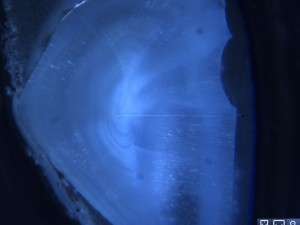John Mohan, UT Marine Science Institute
Otoliths (oto=‘ear’; lith=‘stone) are biogenic carbonates that functioning as hearing organs in teleost fish and accrete permanent growth bands on daily to annual timescales. The elemental composition of fish otoliths are derived from the ambient environment and influenced by physiology, providing detailed chemical chronologies of specific life stages and the types of environments fish encounter. The trace elements Sr and Ba are thought to be incorporated into otoliths by substituting for Ca during precipitation of the CaCO3 crystal lattice. Dissolved Sr:Ca and Ba:Ca ratios vary with salinity and differ between freshwater, estuarine, and marine environments. The Walther Lab measures dissolved elemental ratios in water samples using solution-based ICP MS to characterize spatial and temporal variation in the environment. Laser ablation ICP MS is then used measure elemental ratios in carbonate otoliths to obtain chemical chronologies that span the entire life of individual fish. Understanding relationships between otoliths and water chemistries, allows us to test hypothesis related to fish migration at the individual and population level. This research combines the natural time-keeping properties of fish otoliths and the analytical capabilities of ICP MS to address research questions in the field of fisheries ecology.

a.) Atlantic croaker Micropogonias undulatus, b.) croaker otolith with dashed redline showing transverse sectioning plane, c.) sectioned polished otolith with dashed yellow line showing laser transect from core to edge, d. lifetime elemental profile of Sr:Ca (blue) and Ba:Ca (red) with life stage- specific habitats indicated above, e.) dissolved Sr:Ca and f.) Ba:Ca ratios versus salinity for estuarine (squares) and marine (diamonds) water samples.
© 2024 Jackson School of Geosciences, The University of Texas at Austin


